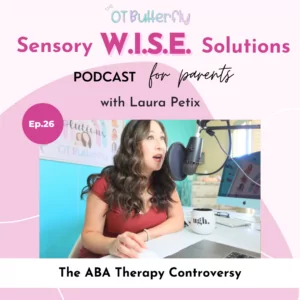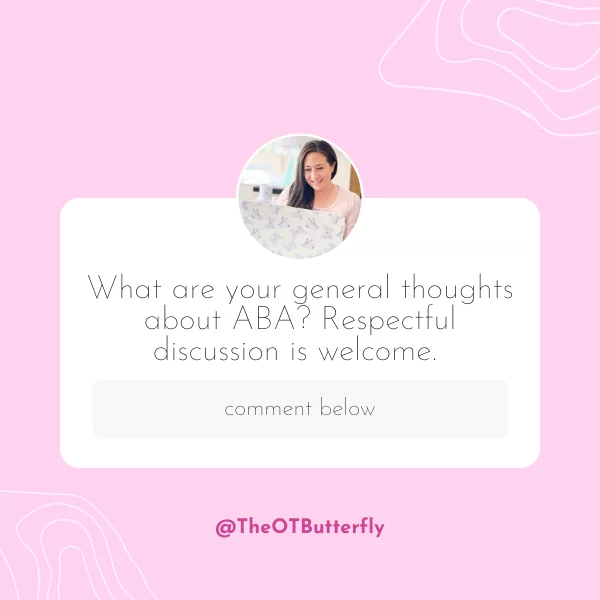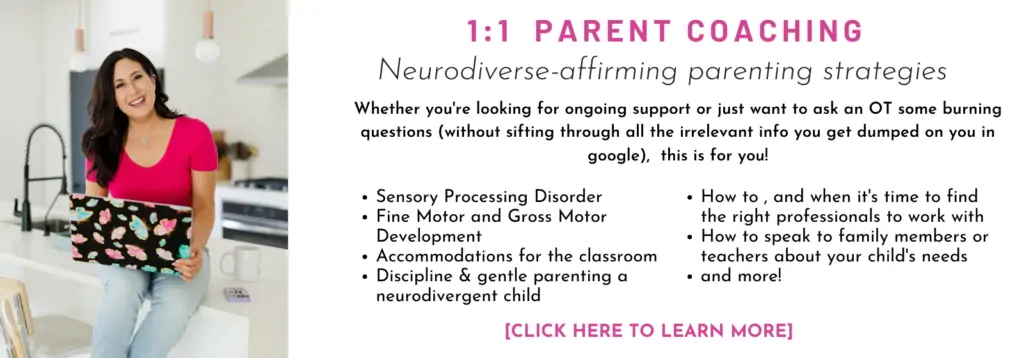Get your FREE sensory profiles cheat sheet >>click here<<
The ABA Therapy Controversy
As an Occupational Therapist, I get asked all the time what my thoughts are on ABA, and if I think ABA is harmful. Keep reading to learn more about an OT’s perspective on ABA therapy, some alternatives to ABA therapy, and how to ensure your Autistic child can thrive even if they are in ABA therapy.
ABA (Applied behavioral analysis) therapy is a type of intervention where people are trained in behavioral analysis and use that lens to manipulate (either increase a certain behavior or reduce another behavior) behaviors in children, it’s most often used and associated with Autistic children.
I’ll be talking about my thoughts on ABA as an intervention for Autistic children, and discuss the practices that have made ABA seem harmful to the Autistic community.
Before you continue, please keep these important things in mind:
- I use identity first language in this episode, such as calling someone Autistic rather than person with Autism. This is what most of the Autistic community prefers, and so, we honor that.
- I actually used to be an ABA therapist, so I have firsthand experience of working in this field. I’ve participated in interventions that now I cringe about, but because I didn’t know any better.
- This is an opinion-based piece. This is my personal and clinical experience with the field of ABA. Not all ABA therapists are the same. Not all OT interventions are the same. I’ve spoken to many more progressive ABA therapists, even some Autistic Adult ABA therapists who are trying to rebrand, reframe ABA, so let’s hope that things can move up from here. And also, keep in mind that ABA interventions are more than just discrete trial training, and more than just the methods I’ll be dissecting here, but again- this episode is meant to bring awareness to some of the more concerning practices that have caused parents to wonder or think that ABA is harmful.
- ABA services are not only for Autistic children, though the controversy that surrounds ABA is mostly linked to Autistic children, so I’ll be using that as my point of reference.
Lastly, please know that if I share an opinion that feels offensive or triggers some emotion in you, that it’s not my intent. My intent is to share my thoughts as a clinician on ABA, and at the end of it all, I acknowledge that right now, ABA is one of the most accessible services to parents of Autistic children. If you have used ABA in the past or are in it now, this doesn’t say anything about you as a person or as a parent.
OK… now having said all that, I’m pretty sure you can already tell my stance on ABA and my general feelings on it, but let’s get into specifics.
My Personal Thoughts on ABA
First and foremost, let’s talk about the Autistic community’s experience with ABA. Many actually Autistic individuals who are adults now are coming forward with their traumatic experience from ABA as a child, calling ABA harmful and abusive. There is a research study that links PTSD symptoms to being exposed to ABA as a child.
Unless you yourself have been a receiver of ABA services, not a parent of a child in ABA, but you yourself were in ABA, then you can’t debunk that experience.
I’d love to say “I was not abusive to my clients as an ABA therapist”, but you know what? I don’t know if I caused any trauma in my previous clients. I don’t know if the ABA I provided was harmful to my old clients. We just need to have compassion for those individuals who are sharing their experience.
Many Autistic individuals talk about the trauma related to being forced to mask their stimming behaviors in order to access a reward or a preferred activity. Many Autistics also talk about how much anxiety and cognitive fatigue it caused them to be forced to make eye contact.
Again, this doesn’t mean that all ABA therapists now, or that all ABA therapists in the past were intending to cause harm to these children, but the fact of the matter is, there was damage done, to a lot of Autistic individuals. On the other hand, I do sometimes see comments from families who say it was such a positive light in their lives.
Autism Diagnosis and ABA referrals
It’s important to acknowledge that parents who utilize ABA therapy are doing so with the ultimate good intent. You want to help your child. You want your child to thrive. And, to be quite honest, most parents basically get a referral to ABA the same day they get the Autism diagnosis. It’s like a hand in hand thing. So here you are, anxious, confused, overwhelmed as you’re told your child has Autism, then in the same breath, the professional that diagnosed your child then tells you that ABA is your next step. This is often how parents get to ABA.
To many parents, ABA is the only service that you’re told about, or maybe it’s the only service you can afford because it’s so widely covered by insurance, as opposed to occupational therapy, speech therapy or play therapy.
Pediatricians LOVE referring to ABA because it’s so data driven, and there’s a lot of research on ABA. But I’m here to remind you… just because something is “evidence based”, it doesn’t mean it’s ethical.
I do understand and believe in the science behind behaviorism, which is the idea that you can condition or change a person (or animal’s) behavior by using rewards, punishments, reinforcements, whatever you want to call it. I have seen it work. Your child has a certain behavior, then you look at what happened immediately before and immediately after and find ways to manipulate the antecedent or the consequence. Overtime, with certain reinforcements, the idea is you can eliminate or change the behavior. What I don’t like is how many (not all) ABA therapists choose to apply this and completely negate the human psyche and mind and emotions altogether.
For example, I really dislike when ABA therapists focus on decreasing stimming behaviors like hand flapping, or when they make it a goal to force eye contact.
I also have a huge problem with the amount of hours of therapy that ABA centers not only recommend, but sometimes require of their clients.
There’s also been an aspect of ABA therapy that even OTs sometimes are guilty of, and this is when interventions and methods and goals focus on changing something within a child.
OTs do sometimes do this too, but ABA interventions write entire intervention plans surrounding behaviors they want to change, eliminate or increase. Sure, there are some behaviors that need to be transformed for safety sake, but… if we are truly trying to be neurodiverse affirming, and accepting of Autistic brains, then we should really understand and know that we can’t “un-do” the Autism. We can’t force their brain to do something it’s not meant to do. Instead, we should focus on ways to support their brain and learning and development in ways that offer accommodations, support tools and modifications so they can be successful in their own way.
ABA sometimes focuses on trying to get your child to do things because the neurotypical world wants it that way. Instead, I prefer to work on finding ways to allow the child to be themselves while providing environmental supports and accommodations and supportive tools to be successful.
ABA red flags
These red flags can apply to any developmental therapies,, but the most common offenders are ABA therapies.
So, while I continue to remind you that not ALL ABA therapists are bad, there are some huge red flags that you can look out for if you’re trying to decide whether or not ABA therapy is harmful to your child.
- If you see the ABA therapist withhold preferred activities or toys (including sensory regulation strategies) until your child performs a certain task. This is the same concept as giving them rewards or a break only after they’ve done XYZ tasks. If my child needs a break after 3 minutes instead of the pre-determined 10 minutes, I’m giving her a break.
And what REALLY bursts my bubble is when therapists withhold regulation strategies. I recently heard from so many parents who said that their behaviorist told them that if their child is upset, throwing a tantrum or having a sensory meltdown, that they cannot give the child a sensory tool, or a hug, or a cuddle because it reinforces the “bad behavior”. YIKES. Red flag.
- When a therapist tries to target stimming behaviors that are harmless and writes goals about decreasing those stimming behaviors. Sensory seeking behaviors could be considered in the same category as stimming behaviors. So my rule of thumb is, if the stimming or sensory seeking behaviors are not physically harmful to the individual itself or anyone else in the environment, then we don’t need to focus on it. This includes things like: hand flapping, flicking fingers, head tilting, spinning (in safe spaces), fidgeting, squinting/visual stimming. A lot of therapists will write goals specifically trying to stop stimming behaviors. Why this is harmful is because stimming behaviors are a regulation strategy for Autistic individuals. Asking them to stop stimming is like asking them to stop blinking or breathing. If you ask them to stop stimming, other dysregulated behaviors will eventually pop up and cause more stress.
- If the ABA therapist tells you that they’re working on speech goals or that they can provide sensory integration, so you don’t need to take your child to Speech or OT. ABA therapists do not have extensive training and education related to speech development or sensory processing development. They don’t even have extensive training or education on fine motor or gross motor development. So they cannot and should not ever tell you “I don’t think your child needs OT/Speech.” You need a Speech therapist to tell you whether they think you need Speech or not. You need an OT to tell you whether they think you need OT or not.
- Another huge huge red flag and another big pet peeve of mine, one that is truly specific to ABA is the way they force so so many hours of therapy upon the family. They say unless you commit to 20, 30, even 40 hours of therapy per week, we won’t take you on as a client. I’ve had many clients come to me saying they want to do OT, but they don’t have time in their week because their child was receiving 20 hours of ABA a week!
Again, I have sympathy for parents who feel so desperate to help their child. So when you get approved for ABA services and hear that you need to commit to 20 hours (sometimes up to 40 hours a week for some kids), it’s hard for you to say no or to pass it up. More hours of therapy is probably better right? Actually, not necessarily.
More hours of therapy does not always equal more progress or better outcomes.
This is because our kids are humans! They have interests, hobbies, they get overwhelmed, they need rest, they need play, they need unstructured time. They need balance and moderation. 20 hours of structured therapy per week is extreme in my opinion.
Thankfully I’ve heard from many families who were able to work with centers on bringing the number of hours down, but I’ve heard from way too many families confirming this point. There is no way to slice it differently… a child should never be in that many hours of therapy in a week. I’ve heard the argument that “oh it’s just like school, they’re in school 20 hours a week, therapy is no different”. Actually, therapy is a LOT different and should not be compared to school.
A child needs unstructured time, free play (not free play that’s dictated by a therapist), time to play, time to spend with family. More hours of therapy does not equal more progress. In fact, even in my own practice as an OT, sometimes a family asks for more sessions, and sometimes I have to tell the parents that because the child is already in abc therapy, rather than adding another session with me, maybe the child would benefit from a scheduled playdate or taking a baking class or some other special interest.
Alternatives to ABA Therapy for Autistic Children
So if you don’t want to do ABA therapy, and you have an Autistic child, what are your alternatives?
If you experience behaviors that are impacting your daily life, such as:
- Aggressive behaviors
- Rigidity, being stuck/need to control things
- Meltdowns
- Sensory sensitivities
- Sensory seeking behaviors
- Engaging in self care tasks at home
- Social interaction and participation
Then OT can be a good option for you. An Occupational Therapist an help your Autistic child live life to the fullest, with the perfectly unique, neurodivergent brain they already have. They’ll teach them functional skills while playing to their strengths, building connection and helping them thrive in the world by using accommodations and task modifications.
{Want to work with me directly? Book a call to consult with an OT here}
If the parents are really struggling at home, I like to recommend parents work with a parent coach who specializes in behavior. Sometimes they’re called a behavior coach, but a lot of them have developed more inclusive and neurodiverse affirmative approaches to coaching parents.
Speech Therapy and Play Therapy are also great supports for Autistic children.
How to Make Sure ABA isn’t Harming My Child
So, maybe you’ve decided ABA is the only service you can use right now with your Autistic child, that’s totally OK. I have some tips for you to make sure that your child is treated with respect, dignity and in a neuroaffirmative way.
- Get as involved as possible when the ABA therapist is creating goals and an intervention plan. If a goal makes you feel uncertain at all, trust your gut. If a goal focuses on something that’s not even important to you at all, or maybe feels like it’s focusing too much on changing your child, speak up. Examine each goal and ask yourself, is this trying to make my neurodivergent child fit into a neurotypical world? That should not be the end goal. The end goal is to increase the quality of life that your child has, and forcing them to mask their Autistic traits to please other people does not help that.
- Ask them to play into your child’s strengths, not just focus on their areas of need. Basically, let your child be who they are but supporting them in areas they need help with, but not focusing on trying to change them. Tell your therapist that you’re okay with your child stimming, that you’re okay if they don’t make eye contact. Tell your therapist that you value connection over compliance and ask them to reflect this in their sessions.
- Negotiate and stick to firm boundaries for limited hours of therapy per week. Just try to balance it out so your child (and you) have a few days a week of unstructured time to yourselves, without therapy. How else are you going to have time to actually practice and implement some of the strategies on your own if you get no down time to actually try it?
Let me know what you thought of this podcast, it’s been a long time coming, and definitely has some controversy surrounding it, but I welcome all opinions and voices in this matter, I do just ask that you be kind and accepting, especially when listening to Autistic voices or other lived experiences related to this matter. I’m not an expert on being an Autistic person, and I’m not an expert on living through ABA as a client. So let’s make room for those voices. Please share this episode with people who need to hear it.
Find me on instagram to share your thoughts.
Links:
Transcript/show notes at www.theotbutterfly.com/26
instagram: @TheOTButterfly www.instagram.com/theotbutterfly
email: LauraPetix@TheOTButterfly.com
work with me: www.theotbutterfly.com/parentconsult
ABA & PTSD research article: https://www.emerald.com/insight/content/doi/10.1108/AIA-08-2017-0016/full/html?fbclid=IwAR3vN0MwnuJKqtpB1ml0W3WdY5wqofD_3XvsqwfNhtnaQvbxQxM2IVzwGlo









This is a fresh of air to read. I am a COTA and ABA therapist. Thank you for this article.
Oh, I’m so glad to hear that! Thank you so much for commenting and reading 🙂